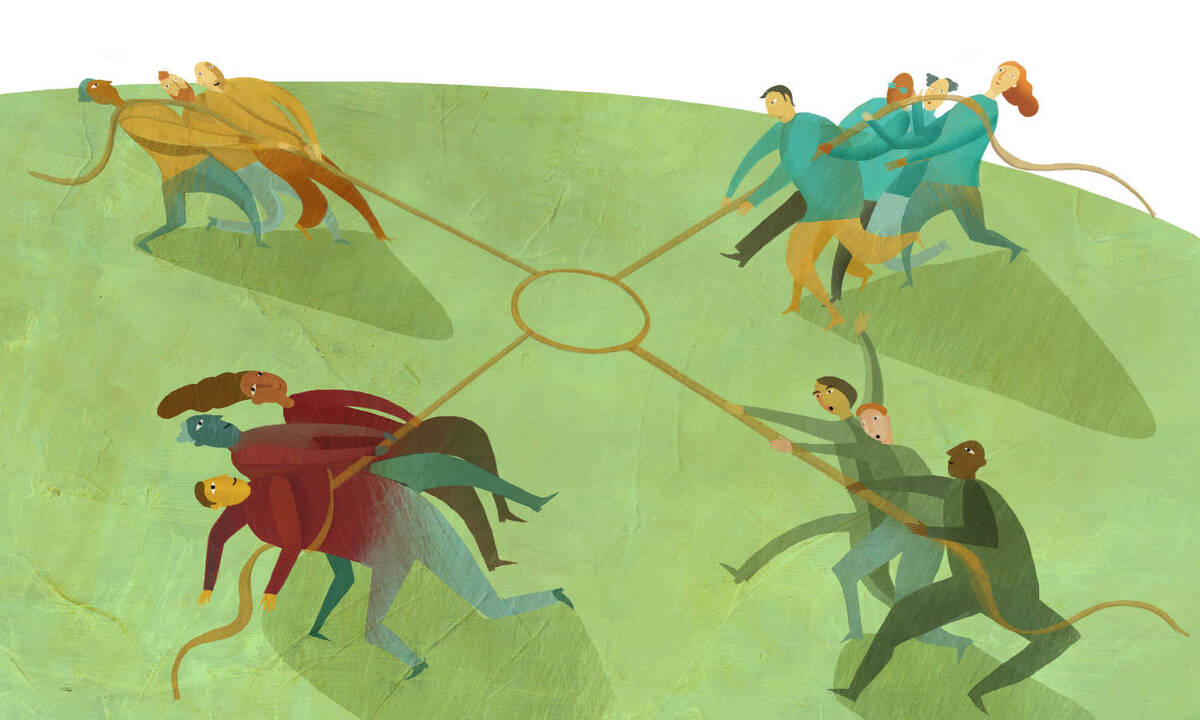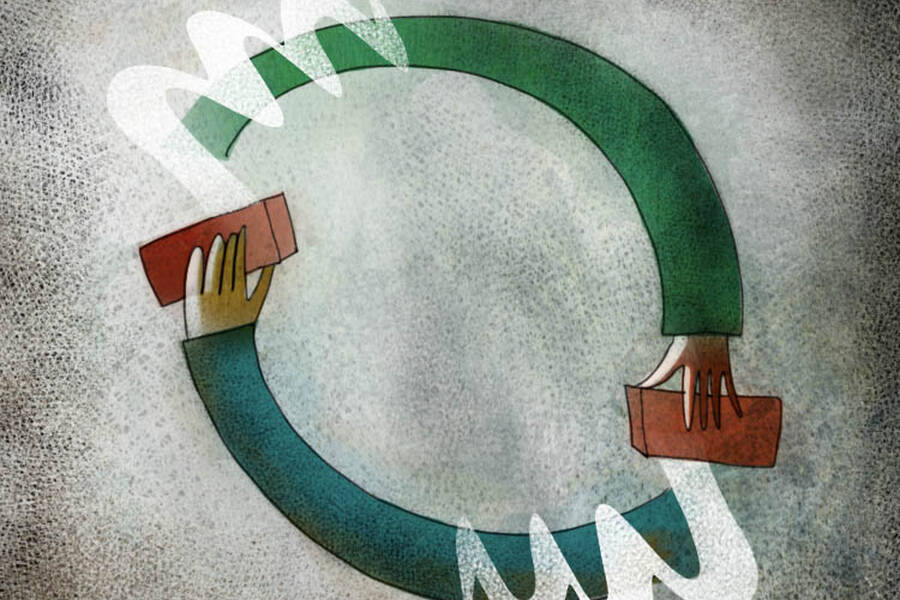But in a time of extreme social and political polarization, asking everyone to get along is unrealistic. And it is also important to remember that some conflict—at least the right kinds of conflict—can be channeled effectively, and even productively.
Kellogg Insight sat down with three Kellogg faculty members, Brian Uzzi, Nour Kteily, and Cynthia Wang, to discuss the psychology and purpose of conflict in our communities, our organizations, and our world.
This conversation has been edited for length and clarity.
Brian Uzzi: Conflict has a lot of social functions.
According to the late sociologist Lewis Coser, human beings can’t develop their own identity unless they’re in conflict with another group that they make different from themselves. But some of this conflict can be nonviolent. Sporting competitions are a way for human beings to channel this and develop their identities.
Of course, some of this conflict does flow into the world of physical violence. Then the functions of social conflict get undercut by all the disadvantages of social conflict.
So we can’t get rid of conflict, but we can find conditions under which it’s generally expressed in a positive way.
Nour Kteily: That reminds me of how anthropologist Allen Fisk talks about conflict as a way of regulating essential relationships.
His argument is that sometimes even the use of physical violence can be very intentional and is intended to regulate social relations. For an extreme example, take someone who engages in an honor killing. This isn’t an act of rage that occurs just on the spot. Typically, it’s something that’s painful that a person doesn’t necessarily take a pleasure in doing, but does to uphold the reputation of his family or community.
Cindy Wang: And sometimes conflict can actually be productive. When you go into a group meeting with somebody who is very different from you, the assumption that there’s going to be a conflict actually leads to better outcomes because you prepare better.
For example, in one study, Katherine Phillips and I gave people tasks and said, “Hey, you’re going to be working with a stranger from the opposite political persuasion.” We then saw that knowing this leads you to start preparing a little bit more for the discussion, because you assume that there is going to be conflict. This drives better decisions in the end, because you’re more prepared and more introspective.
On the other hand, if we come from the same group, we don’t challenge each other as much.
Uzzi: Which is interesting because, to some extent, how we think about another group is normally determined by people in authority positions.
There’s a really classic study called “brown eyes, blue eyes.” It’s chilling. A third-grade teacher decides to run this study about the impact of leadership on groups developing conflict towards one another. She comes in and tells the kids, who have already been friends for months, that it’s now been shown that blue-eyed people are clearly much more intelligent, nicer, and generally better than brown-eyed people.
Then every time a blue-eyed person says something intelligent, she emphasizes how intelligent it is. Every time a brown-eyed person makes even the slightest mistake she says, “Oh. Typical characteristic of a brown-eyed person.” Before you know it, the groups have already separated. The kids are already saying the blue-eyed people are smarter than the brown-eyed people, even though it’s a completely scripted characteristic.
Kteily: Then she reverses it the next day.
Uzzi: Which is really amazing.
Kteily: I never actually interpreted it as a study of leadership. I always thought about it as a study of stereotyping. But regardless, it highlights the power of coalitions in shaping our psychology.
You could think about us as individuals who have moral principles that we always uphold. But many of our moral principles may actually follow from what the coalitions we form are incentivized to believe.
Humans are remarkably effective at motivated cognition. Even motivated memories. For example, we have bad memories for immoral things that we’ve done. There’s also a host of research that shows all the ways in which we can reconceptualize behavior, or excuse our immoral misdeeds, or even overlook some of our hypocrisy. And this motivated cognition extends to our in-group as well.
Wang: You forgive your in-group so much because it’s all about identity! One of your strongest incentives is to maintain this positive identity.
Kteily: The cost of believing otherwise is so high. This reminds me of the people who don’t leave the cult even when the evidence becomes overwhelming.
There are these interesting studies that investigate what happens to a member of a doomsday cult when the time comes and they don’t die. A logical belief might be that they’re just going to walk away because now their faith in this cult has been so eroded. But, in fact, people double down. Part of the reason is because the psychological burden of believing that you have been wrong for long is so overwhelming that you find new ways to convince yourself that you are correct.
Wang: It’s an escalation of commitment. You’re so deep into it that you really can’t turn back at this point.
Uzzi: Then there are the ways social media is contributing to conflict. I thought that social media was going to be so great! In the end, it’s flipped on us in a way we never expected.
We now live in a world where you can choose not to have exposure to other groups and where the way you get heard in your own group is to be ever-more extreme on a dimension that makes you different from other groups. That just pulls groups further and further apart from one another.
And there’s so much misinformation now that people have an inability to process it. When that happens, people look around to see what other people are doing. Then they take that as a rational thing for them to do.
This means, if you have a small but very strongly connected group that has strong, consistent beliefs, that group could trigger everybody else to follow. For instance, the size of the National Rifle Association in terms of membership is quite tiny. It’s smaller than the YMCA. But they’re so consistent and so rigid in their beliefs that they can be a signal for other people to follow.
Kteily: There are certainly a lot of reasons to be pessimistic about the future. And of course we’re having this conversation about conflict during a rise in authoritarian, populist political leadership around the world.
But it is important to remember that we’re a few percentage points away from a radically different reality in many countries. It’s not that the countries themselves are the changing ideologically from one direction all the way to the other. These are sometimes fine margins. If you can mobilize or motivate a certain voter base to vote a little bit more, it wouldn’t take that much for things to shift back.
Wang: I also feel pessimism around fake news and echo chambers. But on the other hand, I believe that more organizations are beginning to recognize the importance of being inclusive as the workforce becomes more diverse.
Kteily: Sometimes you get these paradoxes. For example, one thing that happened after Trump’s Muslim ban is that you actually found liberals supporting Muslims at levels greater than they did before the ban, which on the one hand itself looks like an increase in tolerance, but it’s actually driven by some of the very same coalitional dynamics that are resulting in this polarization.
Wang: There’s always a push and pull.
Even some social activist groups like to stir up conflict. They say, “It’s better than apathy.” With environmental issues, for example, saying nothing, doing nothing, being too polite—these are not good. So conflict can be used for good and for evil. That’s what’s scary right now. We just need to amplify the positive.




